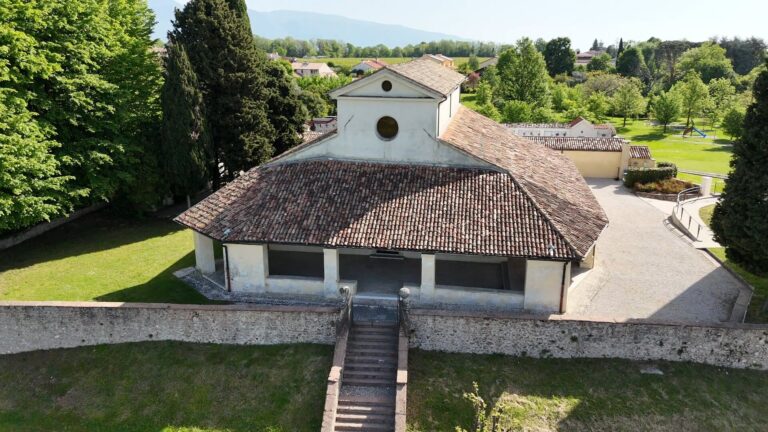ARTISTS’ ROADS
LE VIE DEGLI ARTISTI
watch the videos at the bottom of the page!
SAN PIETRO DI FELETTO
A “Snapshot” of Ancient Trades
In the heart of the “Prosecco Hills of Conegliano and Valdobbiadene” stands one of the emblems of this cultural landscape. It is the Pieve of San Pietro di Feletto.
For those descending from Refrontolo, catching sight of the complex, majestically perched on a gentle rise, is an experience of poignant beauty.
Of Lombard origin, it later assumed its current form, marked by Romanesque features.
In the Middle Ages, it served as a point of reference for the Christian communities of the area, being both a baptistery and the mother church of other chapels.
To reach it, one ascends a flight of steps. A physical movement that already holds the meaning of spiritual elevation.
At the top lies the churchyard, of a most distinctive and functional design. It is in fact a portico. A space of welcome, of shelter, that speaks through the sacred images that “colour” its façade. Always there, always accessible. Even when the church doors are closed. A place that also hosted public gatherings, a space for coming together, for the local and neighbouring communities.
Beneath this airy structure, more than six hundred years ago, an unknown painter, working in a style close to that of Tomaso da Modena, created a powerful image.
You only have to look upwards to see it. It is framed by a rectangular border of double ribbon. At the top, one reads: Sancta Dominicha.
The image is of the so-called “Sunday Christ” or “Feast-Day Christ”, a unique example in the Treviso area but following an iconography widely seen across the Alpine arc between the thirteenth and fourteenth centuries.
The artist shaped every detail with skilled, assured drawing, and used only a few colours: ochre, brown, red, applied on a milky background. The effect is warm. Soft, yet sharp.
At the heart of the composition is Christ. His appearance is unmistakable: the halo is cruciform, his side and extremities bear the marks of the Passion.
His full-length figure faces forward, occupying the entire height of the space. He seems suspended, with arms held slightly away from the body and feet apart. But his gaze is alert. And his complexion is rosy, luminous, achieved with a liquid, translucent pigment laid on in delicate glazes.
Christ looks to his left, the side where the sinners stand.
Around him float, as if suspended in time, dozens upon dozens of tools, objects, animals, and human figures, a sort of rich gallery of allusions to labour and domestic activity.
We are around the 1380s, and this inventory-like list appears to us today as a vivid snapshot of the everyday life of the time. Artisans, merchants, farmers. The blacksmith, the weaver, the baker, the farrier, the cobbler, the cook, the hunter. And again, the barber, the goldsmith, the tailor, the carpenter, the stable boy…
And if to keep the Sabbath means to take part in the Eucharistic sacrifice and suspend all work, for married couples it also meant refraining from physical intimacy.
To each kind of “offence”, there corresponds a wound on the body of Christ from which a stream of blood flows. The stains on his tunic are many and unrelenting. The garment appears as a workman’s robe, with comfortable short sleeves and a frayed lower hem. But its cut, the precious borders on the shoulders and the cross motif on the belt make it a liturgical vestment.
Christ, both worker and priest, warns us: Do not labour on the Lord’s Day!
MORE EXPERIENCES!
L’arte come foto di un’epoca. La cultura materiale:
- XV e XVI secolo: la Sala dei Battuti di Conegliano
- I Murales contemporanei di Fratta e Colmaggiore
- Il XVI secolo: la pala di Lago
- XIV e XV secolo: Santa Maria Nova di Soligo
MULTIMEDIAL MAP: “ARTISTS’ ROADS – LE VIE DEGLI ARTISTI- EN”!

